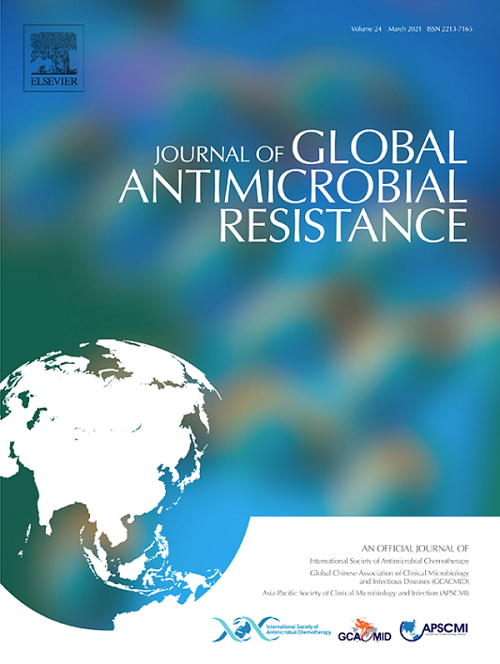A comprehensive analysis of the epidemiological and genomic characteristics of global Serratia Marcescens
IF 3.7
3区 医学
Q2 INFECTIOUS DISEASES
引用次数: 0
Abstract
Background
Serratia marcescens outbreaks present significant challenges in clinical treatment, necessitating a deeper understanding of its epidemiological and genomic traits.
Objective
To analyse the epidemiological and genomic characteristics of S. marcescens at a global scale.
Methods
High-quality genomes of S. marcescens were retrieved from NCBI and annotated using Prodigal. Antibiotic resistance genes (ARGs) were identified via Blastn, sequence types (STs) were determined with a proprietary tool, and phylogenetic analysis was conducted to explore evolutionary relationships.
Results
The study analysed genomes from 33 countries, with major contributions from the USA (27.8%), UK (15.3%), Italy (14.7%), and Japan (10.7%). Human clinical samples accounted for 73.5% of the isolates, primarily from blood (44.8%) and sputum (19.3%). Eleven ARGs were identified, with sde being the most prevalent. Carbapenemase genes included blaSME, blaKPC, and blaNDM-1, though co-occurrence in individual strains was absent. Novel ARGs, including armA, rmtC, and fosA7.2, were reported. Among 855 genomes with identified STs, ST366, ST367, ST365, and ST423 were most common. Phylogenetic analysis highlighted significant genetic diversity and distinct evolutionary lineages.
Conclusion
Temporal analysis showed a genome peak in 2019, underscoring the global prevalence and adaptability of S. marcescens. The distribution of ARGs across diverse STs emphasizes horizontal gene transfer as a key driver of resistance. Judicious antibiotic use is essential to mitigate further resistance.
全球粘质沙雷菌流行病学和基因组学特征的综合分析。
背景:粘质沙雷菌的爆发给临床治疗带来了重大挑战,需要对其流行病学和基因组特征有更深入的了解。目的:分析粘质葡萄球菌在全球范围内的流行病学和基因组学特征。方法:从NCBI中检索高质量的粘多糖基因组,并使用Prodigal进行注释。通过Blastn鉴定抗生素耐药基因(ARGs),使用专有工具确定序列类型(STs),并进行系统发育分析以探索进化关系。结果:该研究分析了来自33个国家的基因组,主要来自美国(27.8%)、英国(15.3%)、意大利(14.7%)和日本(10.7%)。人类临床样本占73.5%,主要来自血液(44.8%)和痰(19.3%)。我们确定了11种arg,其中side最为普遍。碳青霉烯酶基因包括blaSME、blaKPC和blaNDM-1,但在个别菌株中没有共现。报道了新的arg,包括armA、rmtC和fosA7.2。在855个鉴定出STs的基因组中,ST366、ST367、ST365和ST423最为常见。系统发育分析突出了显著的遗传多样性和明显的进化谱系。结论:时间分析显示,2019年出现了一个基因组峰值,表明粘质葡萄球菌在全球的流行和适应性。ARGs在不同STs中的分布强调水平基因转移是抗性的关键驱动因素。明智地使用抗生素对于减轻进一步的耐药性至关重要。
本文章由计算机程序翻译,如有差异,请以英文原文为准。
求助全文
约1分钟内获得全文
求助全文
来源期刊

Journal of global antimicrobial resistance
INFECTIOUS DISEASES-PHARMACOLOGY & PHARMACY
CiteScore
8.70
自引率
2.20%
发文量
285
审稿时长
34 weeks
期刊介绍:
The Journal of Global Antimicrobial Resistance (JGAR) is a quarterly online journal run by an international Editorial Board that focuses on the global spread of antibiotic-resistant microbes.
JGAR is a dedicated journal for all professionals working in research, health care, the environment and animal infection control, aiming to track the resistance threat worldwide and provides a single voice devoted to antimicrobial resistance (AMR).
Featuring peer-reviewed and up to date research articles, reviews, short notes and hot topics JGAR covers the key topics related to antibacterial, antiviral, antifungal and antiparasitic resistance.
 求助内容:
求助内容: 应助结果提醒方式:
应助结果提醒方式:


